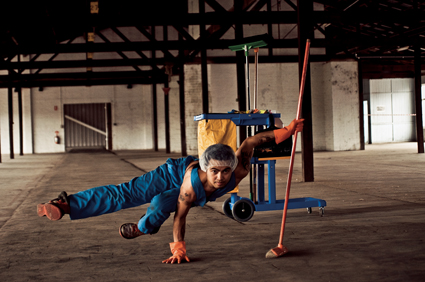the invisible workers dance
keith gallasch: sweat, branch nebula, performance space

Sweat, Branch Nebula
photo James Brown
Sweat, Branch Nebula
FOLLOWING THE SUCCESS OF PARADISE CITY (see review), WHICH TOURED AROUND AUSTRALIA AND TRAVELLED TO SOUTH AMERICA, SYDNEY-BASED BRANCH NEBULA’S LATEST WORK IS SWEAT, A SHOW ABOUT WORK FEATURING PARKOUR, B-BOYING, FOOTBALL, NOISE ART AND DANCE. I SPOKE WITH THE COMPANY’S DIRECTORS LEE WILSON AND MIRABELLE WOUTERS ABOUT THE SHOW FOCUSING ON JUST HOW IT WAS ENGAGING WITH ITS COMPLEX SUBJECT.
One of the challenges in creating a show about work is how to represent it. Although keen not to give too much away Wilson and Wouters seem to be aiming for a balance between representing work practices performatively and at the same time showing Sweat itself to be a form of work. Potential audiences are advised that there will be no seating and Wilson mentions that sound equipment and lights will also be on the move in the space, “but we wouldn’t want it to be read as a show about setting up a theatre show.”
What’s significant for the directors is that they’re looking at a contemporary notion of work and not in the usually anticipated factory or industrial setting: “We’re concerned particularly with low paid and services industry work that we often see around us, and at the way we engage with these services on a day-to-day basis.” Wilson explains that he’s interested “in the intimacy we can share with someone who’s providing a service for us but at the same time we have no knowledge of them—who they are or where they come from. Through the course of the show we’re interested to bridge that gap.” As for the work itself, “We try to evoke images and associations for the audience without trying to be too specific about particular forms. You might see images of cleaning, for example, but we’re more interested in issues of power and status for the low-paid worker.”
When researching and developing Sweat, Wilson says that the company “played with the idea of integrating the artists’ skills into the physical language of work but found that resulted in a ‘Cinderella’ effect. For example, mopping a floor and then transcending that into a complex choreography may be very beautiful but it just doesn’t seem very realistic. What we’ve tried to do is to have the skills entering into Sweat almost in opposition to the work—as a way of conveying something personal about the performers. It’s a way of connecting with the performers on a human level.” At the same time, says Wilson, “We’re looking at the way self-esteem is eroded by being constantly in service for very low pay and how that can affect workers psychologically.”
Wilson says “in this show our interest is not about relationships between the performers, but between performers and audience. That’s a real challenge for us. We’re very good at creating relationships between different forms, how football and B-boying might have a conversation and so on. But for Sweat, we’re supporting the artists to pursue their own practice and develop their material but also prodding and provoking them to extend that material choreographically.”
As the show’s designer, Wouters is focused on the impact for an audience entering a space without a set as such and with the staging shaped by the movement of performers and equipment. Not only is the work therefore inevitably site-specific but costumes are also important: “There’s the work wear—overalls for grunt-work—and then there’s the service work clothing—pastel colours and whites. The costumes are working really powerfully. The moment the performers put them on, they become something else.
It has to do with the invisibility of the people doing these tasks, like the cleaning that happens around you. It’s like it needs to be invisible, as if we don’t want to notice the people doing it.”
The sound for Sweat is by Hirofumi Uchino. As with the other artists in the show, Wilson says, “We’ve tried not to work with him as a sound designer, but as an artist and a noise musician. But the show is different from a noise gig where you go for an extreme experience—some of what Hiro can do feels like it’s changing your DNA. But he has enjoyed the challenge of working outside that framework. What he does with noise will reflect on the psychological aspects of continuous, monotonous or uncomfortable or dangerous or dirty work. I find that the noise in combination with the material we’re doing really does give a psychological weight to the work and has the power to shift you viscerally.”
Wilson spoke of the company’s ambitions for Sweat: “We’re certainly hoping to reach different audiences and experiment with how audiences react to it. I think it will be a unique experience because there are quite a lot of ingredients coming together, whether it’s intimate choreography performed around you or larger scale technical aspects. There are text-based elements and noise. Then there’s the combination of forms—parkour, B-boying football and dance. It’s a pretty amazing mix of stuff. At the same time I think it’s a challenging work. We haven’t set out to make a necessarily ‘pleasing’ show.” But, adds Wouters, “Although the whole set-up for the piece might be out of the ordinary and not something audiences will necessarily be used to, the actual material is quite accessible—it’s something that’s quite close to everybody’s day-to-day life.”
With an appropriately young, ethnically diverse and talented cast—a Sri Lankan soccer player (Ahilan Ratnamohan), a Colombian performance maker (Claudia Escobar), a Filipino/Spanish contemporary dancer (Marnie Palomares), a Vietnamese parkour/martial artist (David Vo), a Bboy (Erwin Fennis) and a Japanese noisician (Hirofumi Uchino)—and Branch Nebula’s trademark inventiveness, Sweat promises to be a significant comment on and a new immersive look at work.
Branch Nebula, Sweat, co-creators Mirabelle Wouters, Lee Wilson, producer Performing Lines; Performance Space, CarriageWorks, Oct 19-30, www.branchnebula.com; tickets www.ticketmaster.com.au
See the RT Studio entry of Sweat in development
RealTime issue #99 Oct-Nov 2010 pg.






